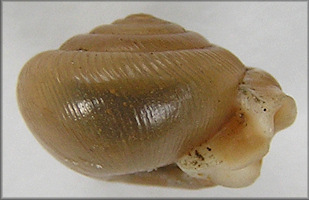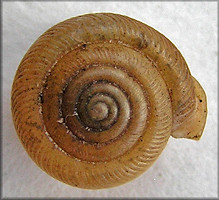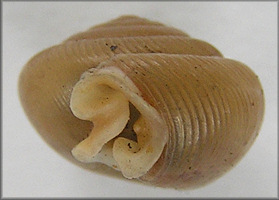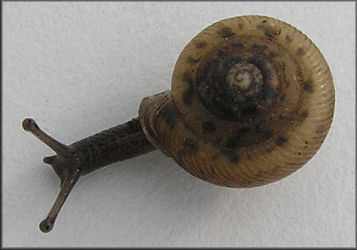Morphology
Daedalochila peninsulae is a
Gastropod and therefore has the characteristics of that class.
These characteristics, stated in its
Classification, include one
shell made of calcium carbonate, and a body plan that shows
coiling and torsion. The shell of Daedalochila
peninsulae is shown in multiple angles below to provide an
image with which specific features can be seen:




As can be seen above, the shell of Daedalochila peninsulae
has an aperture that appears to be pinched. This pinching, shown
well in the third picture, is attributed to the extended
parietal callus and the basal tooth. The parietal callus
is the portion of the pinching of the aperture from the left on
picture 3, or also shown from behind in picture 1 on the far
left. The basal tooth complements the parietal
callus in the pinching, and is shown in the bottom right of the
aperture in the third picture. This type of aperture structure,
given the common name Liptooth, is characteristic of the Genus
Daedalochila.
Also, as seen from the pictures above, the color of the shell
tends to be a light to caramel brown.
Shell size, although not documented widely, has been recorded
and listed to be around 8.5mm (www.jaxshells.org
2010)
The periphery of the shell is very much rounded. Along
with a rounded periphery, coiling of the shell creates embryonic
whorls, both of which are seen clearly in the pictures above.
Another possible differentiating feature is the spire.
Daedalochila peninsulae has a short spire, shown in the
first and third pictures.
This information alone can differentiate Daedalochila
peninsulae from most species, however visualizing a live
specimen can reveal any external distinguishing features:
Seeing a full specimen reveals the tentacles and head. It is
much easier to visualize what a live specimen would look like
when knowing what the external features of the snail look like.

Daedalochila peninsuale is found very rarely living in its
natural habitat, so next time you're in northeast Florida, check
alongside the roads in wet, sunny locations and see if you can
spot it.
All information on this page is observed from pictures
provided by
www.jaxshells.org.
Continue to Facts to learn
interesting facts about Daedalochila peninsulae and its
relatives.
Or return to the Homepage.